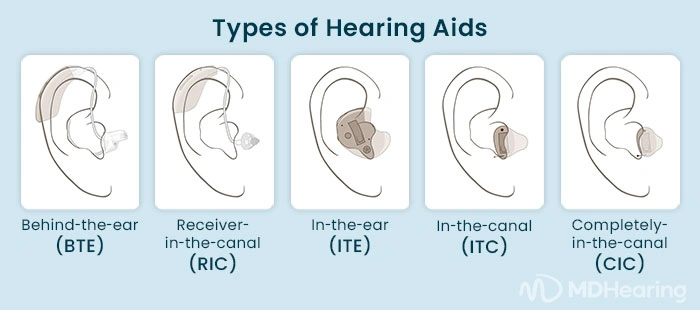For decades, hearing clinics have been the standard way for people to access hearing care. These days, there are more places than ever where you can get hearing aids in person—clinics, private practices, hearing aid retailers, wholesale stores, big-box retailers, pharmacies, and more. Since the FDA’s ruling on over-the-counter (OTC) hearing aids in 2022, consumers in the United States have never had more options when it comes to buying hearing aids.
With e-commerce also becoming the norm, you might be wondering: “Can I buy hearing aids online?” The answer is a resounding “YES!”
With a variety of telehealth providers readily available, there’s never been an easier way to get hearing aids on your own, delivered straight to your doorstep. You can even complete your hearing test online and receive consultations from audiologists and other hearing professionals, all from the comfort of your home.
Buying hearing aids online offers many benefits, from convenience to massive cost savings. Before you pull out your credit card, though, it’s important to understand what online hearing aids entail. Factors such as quality, pricing, and other features can vary widely and could significantly impact your ultimate satisfaction with your choice of hearing aids.
To help answer many of the most common questions, we’ve put together this guide to buying hearing aids online. Please use the following quick links to navigate the article:
- The Benefits of Buying OTC Hearing Aids Online
- Step 1: Determine If You Qualify for OTC Hearing Aids
- Step 2: Do Your Research on Online Hearing Aids
- Step 3: Choose an Online Hearing Aid Provider
- Step 4: Buy Hearing Aids Online
- Step 5: Get Support from a Hearing Professional
The Benefits of Buying OTC Hearing Aids Online
In the past, consumers were limited to the hearing aids offered by their local hearing clinic. Buying hearing aids online has opened up many more options, with advantages such as:
-
Convenience: Every step of the process of buying hearing aids can be done online: taking a hearing test, placing an order, getting customer support, and consulting a hearing professional. This is especially helpful for those who have difficulty accessing an in-person hearing clinic, such as people who live in remote areas or have limited transportation options.
-
Broader selection: While in-person hearing clinics typically have a limited inventory, there are many more brands, models, and price points available when you buy hearing aids online. Being able to pick and choose from among online hearing aid retailers lets you find the device that best matches your unique needs, lifestyle, and budget.
-
Lower cost: Hearing aids can cost as much as $4,000 to $8,000 at an in-person hearing clinic, which leaves many potential buyers with sticker shock. Unfortunately, most Medicare and insurance plans don’t cover the use of hearing aids. Online hearing aid providers, on the other hand, can lower their expenses by cutting out the middlemen and thus offer hearing aids for just a few hundred dollars.
-
Doing research: When you buy hearing aids online, it’s much easier to compare features and read reviews from users and experts. This empowers you to make a more informed and confident decision, without feeling pressured by a sales-driven environment (such as at your local hearing clinic).
Step 1: Determine If You Qualify for OTC Hearing Aids
OTC (over-the-counter) hearing aids have revolutionized the field of buying hearing aids online. In August 2022, the U.S. Food and Drug Administration (FDA) created a new classification for OTC hearing aids that allows them to be sold in pharmacies and traditional retail outlets—without the need for an exam, prescription, or fitting from an audiologist.
Like prescription hearing aids, OTC hearing aids are medical devices that are effective at treating many people’s hearing loss. However, there are a few things you should know before you buy:
- You must be 18 years or older to buy OTC hearing aids.
- OTC hearing aids are only approved for treating mild to moderate hearing loss. For severe hearing loss, patients must be fit with prescription hearing aids from a clinic.
- OTC hearing aids should be labeled according to FDA standards, describing what the device does and how it can help treat hearing loss.
Are you thinking about buying OTC hearing aids? The first step is to understand if they’re right for you. Some of the most common signs of hearing loss include:
- Having difficulty following conversations
- Speech seems muffled or unclear
- Asking people to speak up or repeat themselves
- Turning up the volume on the TV or radio
- Problems hearing high-pitched noises
If you believe hearing aids could help you, you’ll want to take a hearing test to determine your level of hearing loss. MDHearing offers a free online hearing test that takes 8 minutes and gives you personalized results instantly. Your local audiologist or hearing clinic should also offer hearing tests.
Step 2: Do Your Research on Online Hearing Aids
The next step when you buy hearing aids online is to decide what kind of device you want. There are multiple types of hearing aids that are worn either behind or in the ear, depending on the design.
Behind-the-ear (BTE) hearing aids, as the name suggests, consist mainly of a small, curved case that sits behind the ear. This case contains the hearing aid’s electronics as well as its speaker. A discreet, clear plastic tube and tip then funnel noise from the speaker into the user’s ear.
Receiver-in-the-ear (RIC) hearing aids are similar to BTEs in that they feature a small, curved case that rests behind the ear. However, unlike BTEs, the speaker in a RIC device is separate from the case and is positioned directly in the ear canal, connected by a thin wire and ear tip.
In-the-ear (ITE) hearing aids, on the other hand, sit entirely within the user’s ear or ear canal, without anything resting behind the ear. ITE hearing aids are further subdivided into types based on their size. For example, some sit within the concha (the bowl-shaped part of the outer ear). Others fit entirely within the ear canal and are nearly invisible to observers.
When choosing between BTE and ITE hearing aids, consider the following:
- Size: BTE hearing aids are typically larger than ITE hearing aids. This has both advantages and disadvantages: it gives BTE devices more room to fit more advanced hearing aid technology and results in less feedback, but can come at the cost of discretion.
- Discretion: ITE hearing aids are smaller and can be more discreet than BTE hearing aids. For example, completely-in-the-canal (CIC) hearing aids (one type of ITE device) are hidden almost entirely within the ear canal. However, BTE hearing aids can also be quite discreet, as usually only a thin tube or wire is visible from the front.
- Features: Due to their larger size, BTE hearing aids can pack more advanced features, more powerful speakers, and longer-lasting batteries. Because ITE hearing aids prioritize a smaller size, they often can’t compete with BTE devices in this respect.
- Maintenance: BTE hearing aids are generally easier to clean and maintain. The body of a BTE device sits outside the ear canal, which means it’s not as affected by earwax, dust, and other debris.
Once you’ve decided between BTE and ITE hearing aids, the next step is to decide which features you need based on your lifestyle. Here are some features you might want to consider:
- Smartphone app compatibility: If you have a smartphone, you can look for a hearing aid with a companion app that allows you to control your device via your smartphone (e.g., adjusting volume, changing modes, connecting to accessories, etc.).
- Background noise reduction: If you’re often in environments with a lot of background noise (such as busy restaurants, social gatherings, or the outdoors), this feature can help you hear conversations more clearly.
- User-adjustable settings: Rather than going to a hearing professional to adjust the hearing aids, many hearing aid wearers can make their own adjustments as best fits their needs (such as volume changes, program settings, or automatic self-fitting hearing aids).
- Rechargeable batteries: Rechargeable hearing aids can be convenient for those who have dexterity issues, or don’t want to constantly be swapping out batteries and carrying extra batteries on the go.
- Dual directional microphones: Directional microphones help hearing aid users focus on sounds from a specific direction, which is especially useful in noisy environments such as a meeting or a crowded room.
Step 3: Choose an Online Hearing Aid Provider
There are many places for you to buy hearing aids online—including major retailers like Amazon and Walmart, as well as dedicated hearing aid manufacturers such as MDHearing, Jabra, and Lexie.
Large retailers such as Amazon and Walmart have the benefit of a wide product selection. (See our articles on Amazon hearing aids and Walmart hearing aids.) However, there’s one thing to be aware of: many of the “hearing aids” for sale on these websites are actually cheap PSAPs (personal sound amplification products).
Hearing aids are intended to help people with hearing loss by amplifying specific sounds, whereas PSAPs are intended for people with normal hearing who want to amplify all noises around them—like a megaphone inside your ear. While their lower price may seem initially appealing, PSAPs simply aren’t able to treat hearing loss.
Other dedicated hearing aid providers, such as MDHearing, allow you to buy hearing aids online and offer multiple models with different designs and features. For more examples, see our comparison articles on Jabra hearing aids, Lexie hearing aids, and Eargo hearing aids.
How can you tell whether your choice of online hearing aid provider is reputable? Ask yourself questions such as:
-
Are they FDA-registered?
Always check to make sure OTC hearing aids are FDA-registered to ensure a safe, effective hearing care experience. All of MDHearing’s hearing aids are registered with the FDA as class I and class II medical devices. -
Is there a trial period?
It takes time for your brain to adjust to wearing hearing aids and relearn which sounds to filter out. An adequate trial period allows you to wear the hearing aids in your daily routine and make sure they will work for you. MDHearing offers a 45-day risk-free trial period with free shipping and a 100% money-back guarantee. -
Is there licensed follow-up support?
A licensed hearing professional plays a significant role in your hearing health, even when you choose to buy hearing aids online. Hearing aids often require follow-up support—ranging from simple advice on which sound setting to use to more complex troubleshooting or interpreting your audiogram. This is why it’s so important to choose a provider that offers support from licensed professionals, and not just an inexperienced call center. MDHearing provides free lifetime support via phone, email, text, chat, and video call from our U.S.-based in-house team of licensed audiologists and hearing instrument specialists. -
Is there a warranty?
Hearing aids are both a significant financial investment and an essential device for daily quality of life. Warranties not only signify that the manufacturer stands behind its product, but also provide you with peace of mind if the device fails or needs a repair. MDHearing devices come with a standard one-year warranty that protects customers against defects in materials and workmanship, and also offers a Protection Plan for accidental damage. -
How long have they been in business?
With OTC hearing aids gaining popularity, there has also been a rise in online providers—some of which are fly-by-night operations that are looking to make a quick buck and do not support their customers. It’s best to select a provider that has been in business for a long time and has a strong reputation. MDHearing was founded in 2008 by an ENT (ear, nose, and throat) doctor in the Chicago area who wanted to improve his patients’ access to hearing aids, and has served more than a million hearing loss patients.
Step 4: Buy Hearing Aids Online
Once you’ve done your research into hearing aid products and retailers, the next step is to actually make a purchase. While buying hearing aids online has become a quick and easy method, some retailers also offer the option to buy hearing aids over the phone if you prefer. When making the purchase, choose from the available models and features based on your needs and budget.
MDHearing, for example, offers a range of devices, starting at just $297 per pair for our most popular hearing aids. More advanced “smart” models, like the MDHearing VOLT MAX, can be customized for your specific hearing profile with an easy-to-use mobile app and fine-tuned remotely by MDHearing specialists—eliminating that hassle of visiting a busy doctor’s office.
If affordability is a priority, MDHearing is a highly competitive option with lower prices than most other providers. When you place an order, your hearing aids are shipped directly to your door and arrive ready to use right out of the box.
At the time of writing, price ranges from reputable online retailers include:
- MDHearing: $297–$597
- Jabra Enhance (formerly Lively): $995–$1,995
- Eargo: $799–$2,699
- Lexie Hearing: $499–$999
Step 5: Get Support from a Hearing Professional
Last but not least, you may wish to follow up with a licensed hearing professional once your hearing aids arrive. These days, you can use telehealth services to get hearing care from the comfort of your home.
Your hearing provider may offer telehealth services such as:
- At-home hearing tests—online, over the phone, or through a mobile app
- Customized settings for your hearing from a smartphone or tablet
- Live, video-chat appointments with closed captioning
- Consultations with hearing professionals
- Phone and email-based support
- Online video tutorials and articles
When you purchase a device from MDHearing, you have access to clinic-level support from our U.S.-based team of licensed audiologists and hearing professionals—from product recommendations to consultations and troubleshooting. MDHearing also offers a VIP Care option for users who want a more comprehensive, clinic-level experience, including an extended two-year warranty, priority phone support, one-on-one device fitting, and personalized follow-up care.
Final Thoughts
Thanks to the rise of FDA-registered OTC hearing aids and the convenience of e-commerce, buying hearing aids online has never been easier or more accessible. By doing your research on different types of hearing aids (BTE vs. ITE, features, and functionality) and finding a reputable hearing aid provider, you’ll be much more likely to have a positive experience when you buy hearing aids online.
MDHearing offers the closest thing to visiting a hearing clinic without actually stepping foot in one—and at a significantly lower cost. We help you save thousands on FDA-registered hearing aids by cutting out the middleman.
MDHearing’s 45-day money-back guarantee, affordable prices, and U.S.-based professional support team are why we’ve sold more than 2 million hearing aids to satisfied customers. To get started, take our free online hearing test and get your personalized results in just 8 minutes.
Take the next step toward better hearing with our affordable, FDA-registered hearing aids.
COMPARE HEARING AIDS


